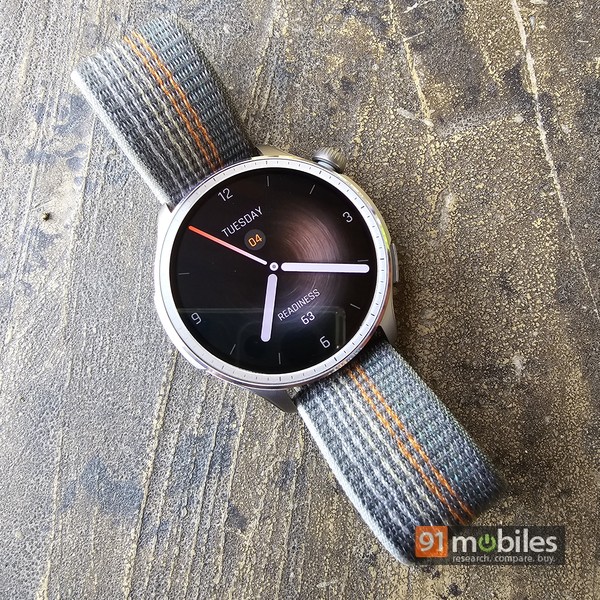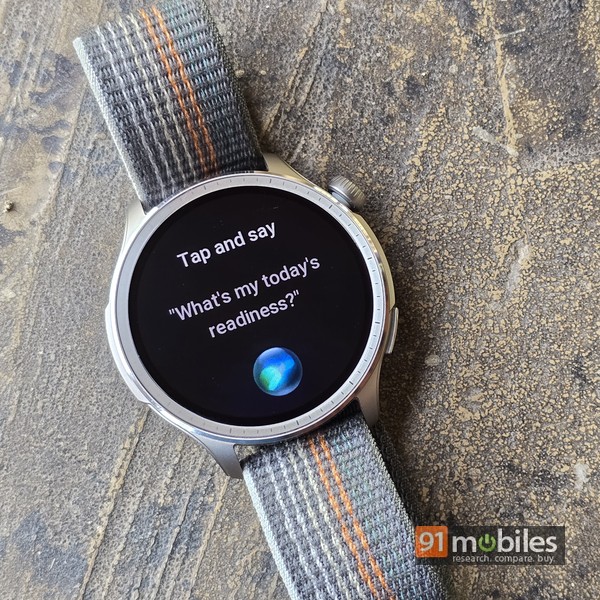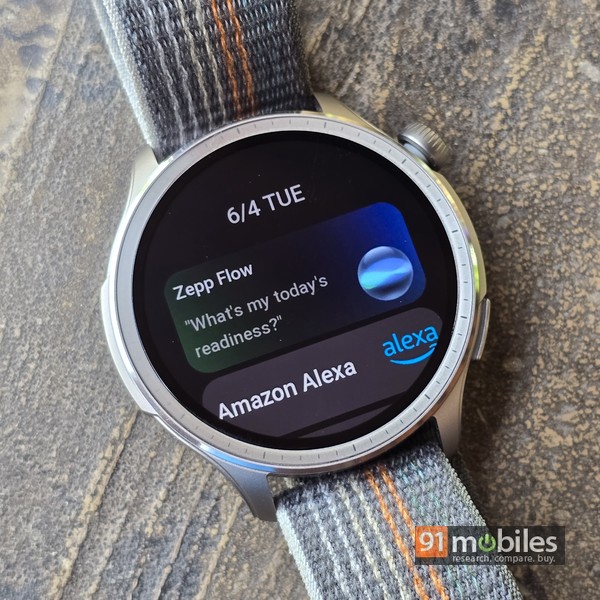Amazfit Balance review: all about finding the right balance
AI is becoming all-pervasive in our lives. So it was only a matter of time before it reached your wrist. The Amazfit Balance is being labelled as an AI smartwatch, but before I even get to that, I must tell you that the device surprises from the get-go. Priced at Rs 24,990, it’s a premium fitness-oriented smartwatch, and that puts it in the premium league. While the affordable segment is chockablock with options, things get tricky when one moves up the price ladder, and the Balance seems to have what it takes to come across as a compelling option. Read on for more.
Design and display

One of the first things you’d notice about the Amazfit Balance is how amazingly lightweight it is. Despite its large metal case, it weighs a mere 35 grams. The nylon strap included as default with my review unit adds just a few more grams to that. The combination looks premium and elegant on the wrist, and stands out without being too flashy. The circular sliver case sports standard lugs, placed 22mm apart.

On the right, you’ll find a rotating crown towards the top, and a hardware key placed slightly lower. A mic placed towards the underside on the right, and a speaker towards the left. The back is adorned with sensors, along with a couple of pogo pins that enable charging when they come in contact with their mates on the charging cradle.

The 1.5-inch, 480 x 480 pixel AMOLED display is quite vibrant, and gets bright enough for easy outdoor visibility. It’s highly responsive too, and apart from boasting an anti-fingerprint coating, is said to be fashioned out of tempered glass for added scratch resistance.
Features
As a premium, fitness-oriented smartwatch, the Amazfit Balance packs in quite a bit. It runs Zepp OS 3.5, Amazfit’s platform that packs in its own app store. The AI capabilities are added by Zepp Flow, an AI assistant that can follow voice commands to control watch functions and provide info.
More on this in a bit. In addition, the Amazfit Balance also includes support for Amazon Alexa. The Balance offers the usual suit of smart features — Bluetooth calling, notifications from a paired smartphone, weather, alarms, timer, stopwatch, calendar, to-dos, world clock, compass etc.

Interestingly, there’s a voice memo feature that allows you to record voice notes or even meeting conversations directly on the watch. This can be used standalone, and the voice recording can be played by via the watch speaker or via connected Bluetooth earphones, or transferred to the phone using the companion app. The watch also has a music player that can play MP3 files offline, after you’ve transferred them to the watch’s native storage via the app. The app also allows the user to add their membership / loyalty cards, which can then be accessed directly on the watch screen. The device is 5ATM water resistant and boasts dual-band positioning along with support for six positioning systems.

The extensive assortment of health and fitness features on board include all the basic ones such as monitoring steps, heart rate (including heart rate variability), sleep, SpO2, stress, etc, along with support for a whole bunch of sports and physical activities, and women’s health features as well. You can make use of meditation and breathing exercises too. While there’s no ECG feature, the Amazfit Balance does let you measure skin temperature, and metrics like BMI, covering body composition with information on skeletal muscle, bone mass etc — providing useful insights on the areas where improvement is needed.
UI and app connectivity

The watch UI is straightforward and works extremely smoothly, without any jitter or lag. Swiping down on the screen displays the quick settings panel, swiping up shows notifications, and swiping sideways displays the widgets. The crown is functional, and pressing it brings up the app drawer, while rotating it scrolls through lists and menu options. The button below is set to launch workouts by default, but you can customise it to launch another app of your choosing. The long-press action of the crown can be customised as well.

The Balance uses the Zepp app to pair with an iPhone or an Android phone. It’s a packed and busy app, and could seem a bit overwhelming to first-time users. Things become easier once you figure out where everything is. The interface is divided into four tabs — home, sleep, workout and profile, with the first one giving you a bird’s eye view of your activity and health data, as captured by the watch.

Be it sleep or workouts, the Zepp app provides detailed data points and metrics that can prove useful, especially if you look at the trends drawn over longer time periods. On a daily basis, the sleep analysis includes info on deep sleep, REM sleep, heart rate, breathing quality, respiratory rate etc. Similarly, going deeper into the data captured from a workout shows points that could be useful for athletes and those training for marathons. Data from my walking exercises includes figures on cadence, altitude, stride, and more, along with the usual metrics like pace, steps, duration etc. Using proprietary algorithms and based on your specific data captured, the app also calculates a numeric value referred to as “PAI”, as a metric of your overall health. While I didn’t find much use for it, I think the Readiness score offered by the app could be useful. The latter indicates how ready you are to take on the day ahead, based on activity and sleep the previous day.

In terms of customisation, the app provides access to a bunch of downloadable watch faces, with many of them being paid ones. That said, if you spend some time browsing the options available, you should be able to find free ones as well.
The Zepp app even provides access an app store, which lets users download apps on their watch. However, the app selection and the choice available does leave a bit to be desired. This is one aspect where Amazfit can do a bit more.
Usage, performance and battery

Overall, the Amazfit Balance does a swell job — both in terms of its smart features as well as a health and activity tracker. I found the activity data to be quite accurate, and the insights offered by the app quite useful too. Of course, the support for Alexa is welcome, and as usual, you can get Amazon’s voice assistant to get weather updates, perform web searches, control compatible smart home devices, and the like. However, the Amazfit Balance also provides access to Zepp Flow, an AI tool that can perform certain actions using voice commands. You can access it via a shortcut widget displayed when you swipe right on the watch face, via its own icon in the app drawer, or by long-pressing on the crown. Using Zepp Flow, you can use natural language voice commands to check your health data, start workouts, control watch settings, and more. While I wouldn’t call it a game-changer just yet, I think it’s a step in the right direction, given how AI is creeping into so many aspects of our lives. In fact, Amazfit Balance also offers an AI coach feature called Zepp Coach, which works out a custom training plan for you depending upon your goals.

The speaker on the Amazfit Balance deserves special mention — it’s possibly the loudest and clearest smartwatch speaker I’ve heard yet. It works well not just for Bluetooth calls, but can even play music stored locally on the watch. Moving on to the battery life, that’s yet another feather in the device’s already well-adorned cap. While the brand promises up to 14 days of use on a single charge, I got roughly 10 days out of it using default settings…. which is extremely good. My usage included 30 minutes of GPS-based workouts five days a week. While the battery life is expected to be lower if features like AoD are turned on and GPS is used extensively, it’s still pretty good. I’d say you should be able to get by with charging it on a weekly basis, give or take a few days.
Verdict

It’s clear that the Amazfit Balance packs in quite a bit, and has a lot to offer to anyone looking for a fitness-first smartwatch. At its asking price of Rs 24,999, it goes up against the likes of the OnePlus Watch 2 (review). Both have their pros and cons, but the OnePlus offering looks more premium and stylish, while its Wear OS platform is better in terms of the app ecosystem and integration with Google services. Both the OnePlus Watch 2 and the Amazfit Balance, however, miss out on smaller-sized variants and don’t offer any cellular options either.
Overall, the Amazfit Balance stands out in aspects like comfort, battery life, and fitness features, and comes across as a compelling fitness smartwatch.
Editor’s rating: 8 / 10
Pros:
- Lightweight and comfortable
- Loaded with AI and other features
- Useful health insights
- Good battery life
Cons:
- Zepp app feels cluttered
- App ecosystem can be improved
- No cellular version
The post Amazfit Balance review: all about finding the right balance first appeared on 91mobiles.com.
https://ift.tt/GDqTstK



No comments